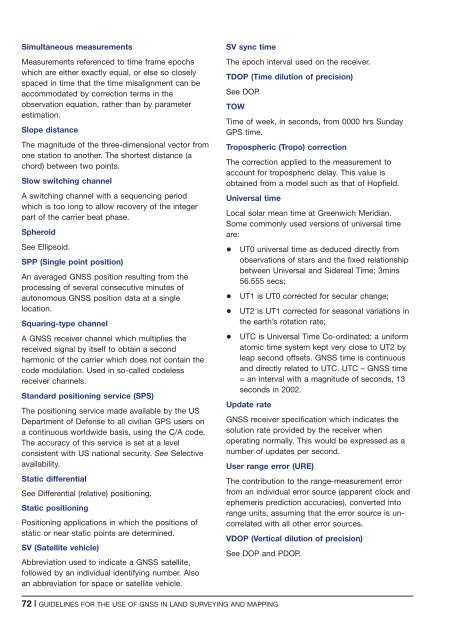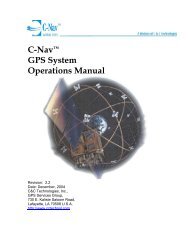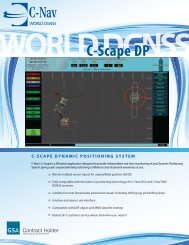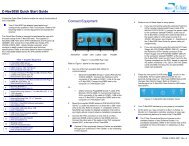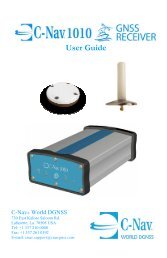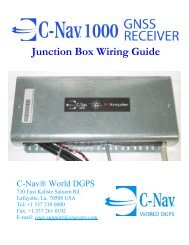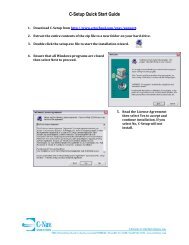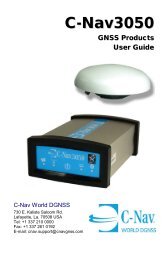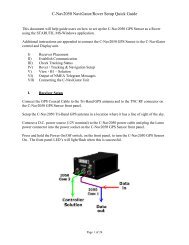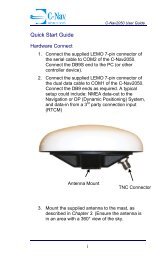Guidelines for the use of GNSS in surveying and mapping
Guidelines for the use of GNSS in surveying and mapping
Guidelines for the use of GNSS in surveying and mapping
You also want an ePaper? Increase the reach of your titles
YUMPU automatically turns print PDFs into web optimized ePapers that Google loves.
Simultaneous measurements<br />
Measurements referenced to time frame epochs<br />
which are ei<strong>the</strong>r exactly equal, or else so closely<br />
spaced <strong>in</strong> time that <strong>the</strong> time misalignment can be<br />
accommodated by correction terms <strong>in</strong> <strong>the</strong><br />
observation equation, ra<strong>the</strong>r than by parameter<br />
estimation.<br />
Slope distance<br />
The magnitude <strong>of</strong> <strong>the</strong> three-dimensional vector from<br />
one station to ano<strong>the</strong>r. The shortest distance (a<br />
chord) between two po<strong>in</strong>ts.<br />
Slow switch<strong>in</strong>g channel<br />
A switch<strong>in</strong>g channel with a sequenc<strong>in</strong>g period<br />
which is too long to allow recovery <strong>of</strong> <strong>the</strong> <strong>in</strong>teger<br />
part <strong>of</strong> <strong>the</strong> carrier beat phase.<br />
Spheroid<br />
See Ellipsoid.<br />
SPP (S<strong>in</strong>gle po<strong>in</strong>t position)<br />
An averaged <strong>GNSS</strong> position result<strong>in</strong>g from <strong>the</strong><br />
process<strong>in</strong>g <strong>of</strong> several consecutive m<strong>in</strong>utes <strong>of</strong><br />
autonomous <strong>GNSS</strong> position data at a s<strong>in</strong>gle<br />
location.<br />
Squar<strong>in</strong>g-type channel<br />
A <strong>GNSS</strong> receiver channel which multiplies <strong>the</strong><br />
received signal by itself to obta<strong>in</strong> a second<br />
harmonic <strong>of</strong> <strong>the</strong> carrier which does not conta<strong>in</strong> <strong>the</strong><br />
code modulation. Used <strong>in</strong> so-called codeless<br />
receiver channels.<br />
St<strong>and</strong>ard position<strong>in</strong>g service (SPS)<br />
The position<strong>in</strong>g service made available by <strong>the</strong> US<br />
Department <strong>of</strong> Defense to all civilian GPS <strong>use</strong>rs on<br />
a cont<strong>in</strong>uous worldwide basis, us<strong>in</strong>g <strong>the</strong> C/A code.<br />
The accuracy <strong>of</strong> this service is set at a level<br />
consistent with US national security. See Selective<br />
availability.<br />
Static differential<br />
See Differential (relative) position<strong>in</strong>g.<br />
Static position<strong>in</strong>g<br />
Position<strong>in</strong>g applications <strong>in</strong> which <strong>the</strong> positions <strong>of</strong><br />
static or near static po<strong>in</strong>ts are determ<strong>in</strong>ed.<br />
SV (Satellite vehicle)<br />
Abbreviation <strong>use</strong>d to <strong>in</strong>dicate a <strong>GNSS</strong> satellite,<br />
followed by an <strong>in</strong>dividual identify<strong>in</strong>g number. Also<br />
an abbreviation <strong>for</strong> space or satellite vehicle.<br />
SV sync time<br />
The epoch <strong>in</strong>terval <strong>use</strong>d on <strong>the</strong> receiver.<br />
TDOP (Time dilution <strong>of</strong> precision)<br />
See DOP.<br />
TOW<br />
Time <strong>of</strong> week, <strong>in</strong> seconds, from 0000 hrs Sunday<br />
GPS time.<br />
Tropospheric (Tropo) correction<br />
The correction applied to <strong>the</strong> measurement to<br />
account <strong>for</strong> tropospheric delay. This value is<br />
obta<strong>in</strong>ed from a model such as that <strong>of</strong> Hopfield.<br />
Universal time<br />
Local solar mean time at Greenwich Meridian.<br />
Some commonly <strong>use</strong>d versions <strong>of</strong> universal time<br />
are:<br />
+ UT0 universal time as deduced directly from<br />
observations <strong>of</strong> stars <strong>and</strong> <strong>the</strong> fixed relationship<br />
between Universal <strong>and</strong> Sidereal Time; 3m<strong>in</strong>s<br />
56.555 secs;<br />
+ UT1 is UT0 corrected <strong>for</strong> secular change;<br />
+ UT2 is UT1 corrected <strong>for</strong> seasonal variations <strong>in</strong><br />
<strong>the</strong> earth’s rotation rate;<br />
+ UTC is Universal Time Co-ord<strong>in</strong>ated; a uni<strong>for</strong>m<br />
atomic time system kept very close to UT2 by<br />
leap second <strong>of</strong>fsets. <strong>GNSS</strong> time is cont<strong>in</strong>uous<br />
<strong>and</strong> directly related to UTC. UTC – <strong>GNSS</strong> time<br />
= an <strong>in</strong>terval with a magnitude <strong>of</strong> seconds, 13<br />
seconds <strong>in</strong> 2002.<br />
Update rate<br />
<strong>GNSS</strong> receiver specification which <strong>in</strong>dicates <strong>the</strong><br />
solution rate provided by <strong>the</strong> receiver when<br />
operat<strong>in</strong>g normally. This would be expressed as a<br />
number <strong>of</strong> updates per second.<br />
User range error (URE)<br />
The contribution to <strong>the</strong> range-measurement error<br />
from an <strong>in</strong>dividual error source (apparent clock <strong>and</strong><br />
ephemeris prediction accuracies), converted <strong>in</strong>to<br />
range units, assum<strong>in</strong>g that <strong>the</strong> error source is uncorrelated<br />
with all o<strong>the</strong>r error sources.<br />
VDOP (Vertical dilution <strong>of</strong> precision)<br />
See DOP <strong>and</strong> PDOP.<br />
72 | GUIDELINES FOR THE USE OF <strong>GNSS</strong> IN LAND SURVEYING AND MAPPING


